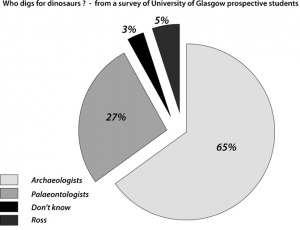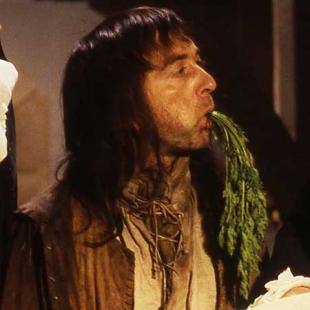The role of TV in geoscience communication
This is now the fifth part in a series exploring the public communication of geoscience, this time focusing on the role that television can play as a communication medium. It is based on, and a development of the ideas conveyed within a paper by Iain Stewart, no stranger to TV himself, and Ted Nield, a writer of popular geoscientific novels and Editor of Geoscientist magazine published by the Geological Society.
The four previous posts, in order, are:
1. Why bother with communication?
2. What do the public already know about geoscience?
3. Who are this ‘public’ we are aiming to communicate with?
4. What is the role of the mass media and newspapers in communication?
Without a doubt, television is a powerful communication tool. I imagine everyone reading this at least owns a TV, and watches a variety of shows of their liking (depending who has power of remote contol). As such, it is, or has the potential to be a powerful national communication tool, especially within the scientific domain.
I’m a palaeontologist, so am going to include Stewart and Nield’s quite relevant case study. In 2007, a hundred prospective students to the University of Glasgow were asked several questions along the lines of ‘who digs dinosaurs?’ (not like that), ‘what does a palaeontologist do?’, and ‘what does an archaeologist do?’. The results of the first of these are shown below.

Firstly, I’m surprised by the small proportion of those who answered ‘Ross’ (the palaeontologist character from Friends), seeing as that’s already my nickname among the new geology undergraduates at Imperial College who I demonstrate to. Secondly, it’s quite disturbing that many students seem unable to distinguish between palaeontologists and archaeologists, albeit not that all palaeontologists actually dig dinosaurs (in fact, many I know have a distinct dislike for them). This is actually quite counter-intuitive, as given the wealth of dinosaur-related films out there, and them being the focus of many Earth science based documentaries, you’d think the distinction would be far more apparent. Apparently not. In fact, speaking with no statistics to back this statement up but based on a general feel of the field, vertebrate palaeontologists, and specifically those that work on dinosaurs, appear to be pretty decent at public engagement with the field relative to other geoscientific disciplines, so you’d think people would actually know what they do. This result above is confounded when 83% of respondents to the second question answered yes, and 100% to the third question answering yes. Clearly this is not a valid representation of the entire public domain, but does raise the interesting question of why, despite the claim for distinction, there is a blurry perception of the two reasonably distinct fields.
While it is possible this conflation is simply due to the difficulty in pulling apart two groups who ‘dig up the past’, the study in which this survey was published suggests that the result may largely be due to where the public receive their information from. A previous survey of the public perception of archaeology revealed that over half of the respondents got their archaeological knowledge from TV (Tony Robinson?), but less than quarter used written media (including newspapers, magazines and books) for such a purpose.

This pattern is reflected in knowledge acquisition regarding the entire domain of science and technology, according to a survey by National Science Foundation (2008). 40% of adults from the US and Europe get their general S&T information from TV, with 28% using the internet, whereas for specific scientific issues, only 21% use TV, and a mighty 54% use the internet, with the rest taken up by radio, newspapers, magazines and friends, family and colleagues. In terms of trends, for general S&T this figure has remained roughly constant in the period from 2001-2008 (for TV), but has more than doubled over this same period for specific science issues, with internet continuously dominating the second category.
The UK Department for Business, Innovation and Skills (BIS) conducted a survey in 2011, revealing that 54% of people obtain scientific information through TV, 32% through newspapers (I wonder how much of this is down to The Metro..), only 19% through the internet. There is also the slightly thought-provoking statistic that only 2% of the UK public use science blogs specifically as one of their most regular sources – the reasons for this could do with further exploration by someone far more qualified than myself). The overall trend is that the general consumption of scientific knowledge is through popular and mainstream television programmes, and for specific issues people turn to the internet, somewhat unsurprisingly.
There are two main categories of programme that geoscientific information can be consumed from – the news, and the, er, non-news. News, by it’s very nature, is rapid, topical, and reactionary. Non-news items, such as documentaries, are more passive in nature, more structured, and designed to inform about specific fields of science or technology, instead of singular occurrences This makes the two intrinsically different modes of communication, both with different audiences, reflected by a dichotomous information content.
Documentaries offer more time for creation, due to their non-reactionary nature, and actually afford good opportunities for the development of working relationships between those in the media and those within the associated scientific area. Both can gain a reciprocal appreciation of operational criteria, agendas, and demands on each in terms of knowledge communication.Note that TV is predominantly a one-way communication tool, not affording the luxury of open communication that blogging and direct contact can bring, distancing itself from forms of digital and direct engagement.

In the grand scheme of science coverage, and specifically in terms of output from the BBC, geology actually fares pretty poorly. In both news and non-news coverage, geology can only be credited with an average of 3% of total scientific output when ranked against the other sciences, falling well short of molecular and medical science, biology, chemistry and physics. This is quite counter to the statistics for newspapers, in which (in 2011), geoscience-based stories were covered more than both physics and chemistry combined, and more than biology. Why this discrepancy exists is unknown, but it may be perhaps due to the ‘lab invasion’ that occurs with media presence, and the disruption that camera and lighting crews, scripts, and phone calls brings to lab life, something that perhaps geologists more than other scientists dislike. Perhaps geoscience is not seen as glamorous enough for television relative to the other sciences, or perhaps there is a general lack of understanding within the geoscientific community about how to engage with the TV media and the protocols within which it operates.
The solution, according to Stewart and Nield, is that geoscientists need to gain more of an appreciation of how the broadcast media works, and for geoscientists to be more targeting in what they want from programmes. My suggestion, as well as this, would be for geoscientists to develop more along other strands of communication such as podcasting and blogging, which may currently have a smaller target audience but can be highly effective modes of communication. The remarkably small proportion of public consumption of scientific knowledge from science blogs shows that there is most certainly room for improvement in the realm of digital communications.
This was originally posted at: http://blogs.egu.eu/palaeoblog/2012/11/23/278/
Wow. I can now answer at least one question about Friends in the next pub quiz. Astonishing the useful things you learn in geology. Now all I need is the gastroliths to be able to stomach actually watching an episode.
Be careful of your assumptions. I only got a TV when I got married, and still use the radio more than the goggle box.
It helps me a lot that one of my better blog buddies (JMMcDowell) is an archeologist, so I can differentiate better. I would have known anyway, but this is quicker. I think of archeologist as working with architecture.
Scott